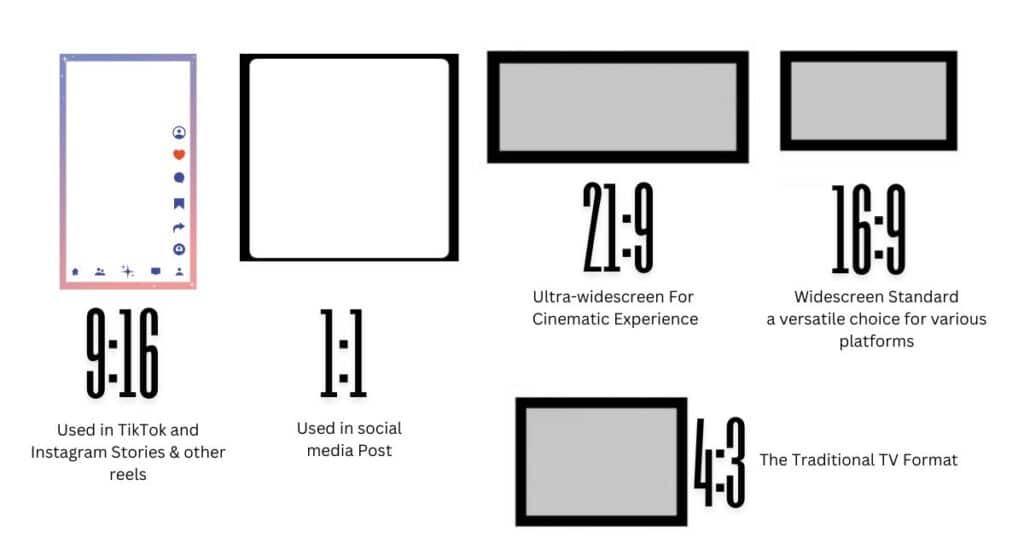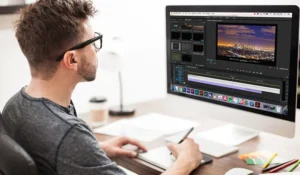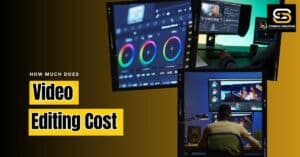Choosing the right aspect ratio is an important factor in videography since it impacts both the view and narration of your content. Making proper choices in aspect ratios ensures high engagement in the video, which means great benefits for meeting expectations according to the platform requirements and audiences. Therefore, let’s look into videography aspect ratios helping you find the right frame for your content, and provide tips on handling aspect ratios when editing.
What is Aspect Ratios

An aspect ratio is the relationship between the width and height of an image or screen. For example, it often takes the form of two numbers separated by a colon; for example, 16:9, or 4:3. The first number represents width, and the second one shows height. For example, the aspect ratio 16:9 represents that the width is 16 units and the height is 9 units.
Why Aspect Ratios Matter
Aspect ratios are important because they determine how your video will be displayed on different screens and devices. The right aspect ratio ensures that your video looks good without distortion or unnecessary cropping. It also affects the composition and framing of your shots, influencing how viewers perceive your content.
Also, know about How Long it Takes to Edit a Wedding Video?
Common Aspect Ratios in Videography

16:9 – The Widescreen Standard
The 16:9 aspect ratio is the most widely used format for high-definition television (HDTV) and online videos. It offers a wide viewing angle, making it ideal for capturing landscapes, action scenes, and cinematic shots. Most modern devices, including smartphones, tablets, and computer monitors, are designed to display content in 16:9, making it a versatile choice for various platforms.
4:3 – The Traditional TV Format
The 4:3 aspect ratio was the standard for television broadcasts and computer monitors before the advent of widescreen displays. While it is less common today, it is still used for certain types of content, such as retro video games and older television shows. The 4:3 ratio provides a more square-like frame, which can be useful for portraits and close-up shots.
21:9 – The Cinematic Experience
The aspect ratio of 21:9, also anamorphic or ultra-widescreen, has generally found great use in film to portray a more immersive view. It allows taking shots of vast lands and epic scenes; it provides for a much wider field of view. This perfect ratio is meant for films and high-end productions that aim to give that cinematic feel.
Other Aspect Ratios
- 1:1: The square aspect ratio is used predominantly in social media platforms like Instagram.
- 9:16: The vertical aspect ratio popularized by platforms like TikTok and Instagram Stories, is designed for mobile viewing.
- 2.35:1 and 2.39:1: Variations of the ultra-widescreen format used in Hollywood films.
Choosing the Right Aspect Ratio
Factors to Consider
When selecting an aspect ratio for your videography project, consider the following factors:
- Platform: Different platforms have different aspect ratio preferences. For example, YouTube favors 16:9, while Instagram favors 1:1 and 9:16 for stories and reels.
- Audience: Consider how your audience will view your content. Are they watching on a TV, computer, or mobile device?
- Content Type: The nature of your content can influence the best aspect ratio. For instance, documentaries may benefit from a 16:9 ratio, while cinematic films might look better at 21:9.
- Creative Vision: Your personal or brand’s creative vision should also guide your choice. Some stories are better told in a specific aspect ratio.
Examples of Appropriate Aspect Ratios
- Documentaries and Vlogs: 16:9, as it provides a good balance of width and height.
- Social Media Content: 1:1 for posts, 9:16 for stories and reels.
- Feature Films and Cinematic Projects: 21:9 or 2.35:1 for a widescreen cinematic look.
- Retro Content: 4:3 for a nostalgic or vintage feel.
Impact of Aspect Ratio on Viewer Experience
Aspect ratios significantly impact how viewers perceive and interact with your content. A well-chosen aspect ratio enhances the visual appeal and ensures that key elements of your composition are appropriately framed.
Storytelling and Composition
The aspect ratio you choose can affect the storytelling of your video. For example, a wider aspect ratio like 21:9 allows for more expansive shots, making it suitable for epic landscapes and action scenes. Conversely, a 4:3 ratio provides a more intimate and focused view, ideal for character-driven narratives and close-up shots.
Viewer Engagement
Different aspect ratios can evoke different emotional responses from viewers. A 16:9 aspect ratio is familiar and comfortable for most viewers, making it a safe choice for general content. A 21:9 ratio, with its cinematic appeal, can create a sense of grandeur and immersion, enhancing the emotional impact of your film.
Technical Considerations of Aspect Ratio
Changing Aspect Ratios in Post-Production
Sometimes, you may need to adjust the aspect ratio during the editing process. This can be done using video editing software such as Adobe Premiere Pro, Final Cut Pro, or DaVinci Resolve. Here’s how:
- Adjusting the Sequence Settings: Change the aspect ratio of your sequence or timeline to match your desired output.
- Cropping and Scaling: Use cropping and scaling tools to adjust the framing of your footage to fit the new aspect ratio.
- Letterboxing and Pillarboxing: Add black bars (letterbox for wide aspect ratios and pillar box for tall aspect ratios) to fit your footage into the new ratio without distorting the image.
Dealing with Aspect Ratio Constraints
When shooting for multiple platforms, you may face constraints related to aspect ratios. Here are some tips:
- Shoot in a Versatile Ratio: Filming in 16:9 allows you to crop the footage to fit other ratios like 1:1 or 9:16 without losing significant content.
- Plan Your Shots: Consider how the composition will look in different aspect ratios and frame your shots accordingly.
- Use Safe Zones: Ensure important elements are within safe zones that won’t be cropped out when adjusting the aspect ratio.
Conclusion
Aspect ratios are a fundamental aspect of videography that can greatly influence the quality and impact of your video content. By understanding the different aspect ratios and how to choose the right one for your project, you can enhance your storytelling and create visually compelling videos that engage your audience.
At Synergy Creations, we specialize in professional video editing services, ensuring your memories are preserved in the most stunning way possible. Contact us today to learn more about how we can help make your video a cherished treasure.








